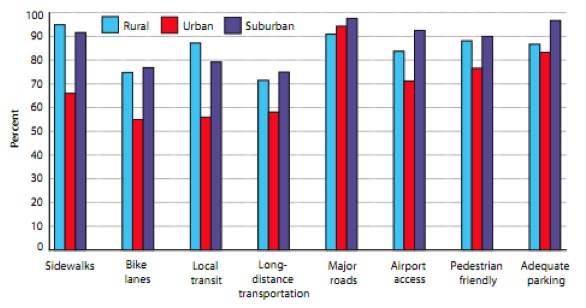When asking people what transportation options are important in their communities, why do poll-takers never ask them to choose between different options? Here comes another survey in which people say they want everything and are never asked to make the tradeoffs that come in the real world.
USDOT’s Bureau of Transportation Statistics asked 1,000 households how important different transportation facilities were to them. (Note: the survey was conducted in 2009 but the results are just being released now.)
Here’s what they found [PDF]. Eighty-five percent said sidewalks were “important” – but 94 percent said major roads were.
| Sidewalks, safe walking routes | 85.0 |
| Bike lanes | 69.8 |
| Reliable local transit that can be reached without driving | 75.3 |
| Long-distance bus or train transportation to/from major metro areas | 68.4 |
| Major roads or highways | 94.4 |
| Easy access to airport | 83.2 |
| Pedestrian-friendly streets downtown | 85.2 |
| "Adequate" parking in the downtown or central business district | 89.2 |
There are some problems with the way these questions were asked. First of all, we get a bee in our bonnet about the question about "adequate" parking. Who would vote for "inadequate" parking?
But more significantly, BTS acknowledges that they’re not really sure what people thought they were saying when they said something was “important.” After all, it seems strange that urbanites (33 percent of survey respondents) ranked livability characteristics like bike lanes, long-distance transportation, and pedestrian-friendly streets as less important compared to suburbanites (39 percent of those surveyed) and rural residents (29 percent).

Says USDOT:
The importance placed on the various transportation characteristics by community type seems to reflect what residents of those communities perceive are needed, but that may not be available. For example, rural and suburban residents were more concerned about having “sidewalks, paths, or other safe walking routes to shopping, work, or school” than those living in an urban setting. This may reflect the fact that urban areas are more likely to already have ample pedestrian walkways, but these are less available in suburban and rural areas.
All of which begs the question of just how much you learn by asking people what’s “important.” Just once, I’d like to see a survey ask people what they would give up. If, just for the sake of argument, lots of parking doesn't really coexist with walkability in a central business district – or if there’s not enough money to build lots of roads and lots of transit – what’s more important? In the real world of trade-offs and scarcity, what would these 1,000 households prioritize?
According to the report authors, respondents were asked whether these livability attributes were "very important,” “somewhat important,” “somewhat unimportant,” and “not important” -- but that precision didn't make it to the final report. Why not ask them to pick the two most important items on the list of eight? Or actually define importance as what transportation options make, or would make, the respondent's community function best?
Insofar as this report can tell us anything, we did find it interesting to examine the data by age group. Young people (18-34) find sidewalks more important than any other age group (91.5 percent). They’re also pretty into bike lanes (73.8 percent) and way into transit (80.5 percent). However, before you get lulled into that “young-people-don’t-want-cars-they-just-want-iphones” meme, it’s worth noting that they’re also more gung-ho about roads and highways than anyone else (95.9 percent).
And despite the recent focus on making sure senior citizens have access to transit, seniors actually seem somewhat less concerned about transit than all other age groups. After age 65, the “importance” of transit drops from 75.4 percent to 66.2 percent. Interest in sidewalks, bike lanes, and long-distance transportation drops off fairly dramatically at age 65 too.
That last one could be an issue of how the question is phrased. Surveyors asked about the importance of “reliable long-distance bus or train transportation to and from major metropolitan areas.” But if 79 percent of seniors live in suburban and rural areas, as the Brookings Institute found in 2003, they might not relate to a question that asks specifically about major metros.
The survey also grouped respondents by gender (yes, women care more about sidewalks) and income. Interest in bike lanes is around 75 percent for folks who make under $30,000 and those who make between $75,000 and $125,000, but the middle earners and top earners seem somewhat less interested. People with incomes over $125,000 were the most interested in sidewalks (89 percent) and pedestrian-friendliness (91 percent) but they also care a lot about roads (a whopping 98.3 percent), airport access, and parking. They just want it all, I guess. Except transit, that is. Interest in transit dips significantly as incomes go above $125,000.
What do we gain from this survey? At best, some interesting insights into distributions by age and income. But it would be a lot more useful if the questions were more tailored to go deeper into how Americans would make the hard decisions about how their communities should be structured.





